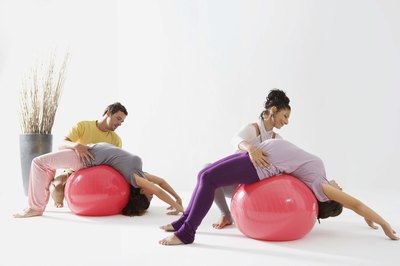
The sacroiliac, or SI, joint is comprised of two L-shaped joints flanking the bottom of your pelvis. Acting as anchors for the pelvic bones, the right and left iliac and sacrum, when injured these joints may cause pain with standing, walking, climbing stairs, pelvic discomfort, and low back pain. While sacroiliac joint dysfunction can be painful, using an exercise ball, which works to develop core muscle strength and improve spine stability, may improve mobility and comfort.
Shoulder Bridge
Using the abdominal, gluteal and hip muscles, the shoulder bridge strengthens the ligaments supporting the sacroiliac joint. With your calves and feet resting firmly against the ball, lie on against a flat surface with your arms stretched to form a cross. While tightening your abdomen, exhale and lift your bottom being cautious not to arch your back. Lower your bottom while inhaling. Placing your arms next to or on your body will increase this exercise's intensity.
Reverse Extensions
Reverse extensions exercise the gluteal, hip, and lower to middle back muscles, providing stability to the sacroiliac joint. Start by centering your stomach over the ball. Place your hands directly under your shoulders while stretching your legs. As you exhale, focus on engaging your abdomen while walking your hands forward. Once the exercise ball is positioned underneath your hips, bring your legs together and lift them from the floor. Lower your legs while inhaling, being careful to keep them together until they have returned to the mat.
Chiropractor Thomas E. Hyde, writing for Spine Health, recommends three exercises that isolate the pelvic floor muscles to aid in rehabilitating the sacroiliac joint. The back-and-forth rock involves sitting on the exercise ball while tilting the pelvis forward and arching back. The side-to-side rock uses hip movement and a left-right swaying pattern, gently rocking the joint. Circles are done while sitting on the ball. Tilt your pelvis, moving your hips in a circular motion.
Knee Tucks
Knee tucks are advance moves that stabilize the core that supports the pelvic ligaments and sacroiliac joint. Move onto the exercise ball, face down, with your shins centered over the ball. Your arms should be under your shoulders. While exhaling, tighten your abdomen, pulling your knees to your chest. As your hips lift from the exercise ball, your head will move downward into a headstand position. Keep your arms straight while resting your shins on the ball. Hold this position for one breath. While inhaling, roll back onto the ball.
Original article and pictures take woman.thenest.com site
Комментариев нет:
Отправить комментарий